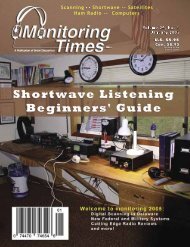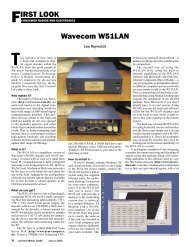RIGHT-click here - Monitoring Times
RIGHT-click here - Monitoring Times
RIGHT-click here - Monitoring Times
Create successful ePaper yourself
Turn your PDF publications into a flip-book with our unique Google optimized e-Paper software.
the frequency; I’m coming back with the Prime<br />
Minister.’ Minutes later the Prime Minister got<br />
on the air and granted permission for the ship to<br />
land.”<br />
Hurricane Allen tracked through the Caribbean<br />
and into the Gulf of Mexico with a final<br />
landfall August 10 at Brownsville, Texas. Luckily,<br />
the 15 foot storm surge would occur over the<br />
least populated part of the region, but it was not<br />
without drama.<br />
Each year WX4NHC launches the hurricane<br />
season with a well publicized test of the<br />
station’s HF and VHF/UHF capabilities. June<br />
2 was the test date for 2012, and the station<br />
racked up 200 contacts which included 60<br />
contacts on EchoLink/IRLP (EchoLink allows<br />
amateur radio stations to contact each other via<br />
Internet connection and IRLP, Internet Radio<br />
Linking Project, uses Voice-Over-IP custom<br />
software to link various amateur radio systems<br />
such as repeaters with the Internet). For the last<br />
nine years WX4NHC has had a Hurricane Net<br />
that cross-links EchoLink and IRLP so that<br />
it can also be linked to the Internet through<br />
repeaters.<br />
During this year’s test, the main computer<br />
that controls EchoLink and APRS had an<br />
overheating problem and shut down. Within<br />
ten minutes their backup computer was put<br />
into service and operations continued. It’s why<br />
they run the test: they never know what will<br />
go right and what will go wrong.<br />
Though the station has the capability<br />
to use BSPK31, a low-power, weak-signal<br />
mode, they don’t use it because most stations<br />
in affected areas during a storm don’t operate<br />
that mode. WX4NHC assistant coordinator<br />
Julio Ripoll WD4R explains, “Due to our<br />
limited manpower and equipment during<br />
most hurricanes that are in the Caribbean or<br />
making U.S. landfall, we have at most three<br />
operators at a time. The operator priorities, in<br />
a non-local landfall are HF (Hurricane Watch<br />
net on 14.325 MHz or night-time 40 meter<br />
backup 7.286 MHz); VoIP Hurricane Net<br />
(EchoLink WX_Talk Conference / IRLP), and<br />
computer operations (including ON-NHC Online<br />
reports, HF-VHF APRS Reports, CWOP<br />
Mesonet Weather Data, WX4NHC e-mails and<br />
HWN Net Coordination Chat Room).<br />
“You can see how busy three operators<br />
can be during a hurricane in the Atlantic,<br />
Caribbean or Gulf, which can last for over a<br />
week, with three hour shifts. During a local<br />
landfall, our operations change to a more<br />
localized mode using all the above methods<br />
and modes plus local VHF and UHF to local<br />
hurricane shelters, local ham nets and local<br />
governmental agencies while maintaining HF<br />
links outside of our local area.”<br />
Ripoll explains how EchoLink can serve<br />
as a vital tool, relaying timely information<br />
from place to place. “People think, ‘EchoLink,<br />
well, it’s Internet-based so, once the Internet<br />
goes out it’s gone,’ but that’s not true. First,<br />
the Internet stays up much longer than you<br />
would think. Secondly, they link other stations<br />
that could not be reached any other way. For<br />
“It was at night and I remember we were<br />
in the offices w<strong>here</strong> the specialists were housed;<br />
we had one desk, the room next to us had about<br />
30 Teletype machines and we were separated by<br />
one wall which was all glass. The machines were<br />
just rattling away and the hurricane forecaster<br />
on duty and Dr. Frank came in and said, ‘Look<br />
at this.’ It was the last Teletype message from<br />
the chief meteorologist at the National Weather<br />
Service (NWS) office in Brownsville and it said,<br />
ON THE AIR AT WX4NHC<br />
example, in 2004 during Hurricane Ivan, we<br />
did not have any propagation from Miami to<br />
Georgetown University in Grenada, w<strong>here</strong> a<br />
station was located. But, t<strong>here</strong> was a station in<br />
St. Lucia talking to Grenada on 40 meters and<br />
he was on EchoLink, so he was able to take all<br />
of the reports from Grenada and retransmit them<br />
on EchoLink which got back to us.<br />
“During one hurricane that hit St. Croix, a<br />
local ham, John Ellis NP2B, whose antennas and<br />
everything else went down, found that the only<br />
thing that was operable was his FAX machine.<br />
So, during the eye of the storm he was FAXing<br />
his reports.”<br />
Station equipment is not new. Their main<br />
transceiver is a Yaesu FT990 that’s about 17<br />
years old. Ripoll reports that it still works great<br />
and, even though they have a newer FT100 as<br />
a backup, they still use the FT990. The station<br />
also has seven antennas on the roof including<br />
HF, VHF/UHF verticals, beams and wire antennas,<br />
including a multiband dipole strung up as a<br />
sloper to favor the Caribbean. They even have<br />
an extra hundred feet of copper wire in a desk<br />
drawer along with an antenna tuner that they<br />
can take out and string up in the event they’re<br />
hit with a Category 5 hurricane and lose all the<br />
antennas on the roof.<br />
When a storm with tropical storm force<br />
winds is pending, the entire NHC building<br />
gets locked down. “Once the steel shutters roll<br />
down,” Ripoll says, “whoever’s in, stays in and<br />
you’re t<strong>here</strong> for the duration of the event whether<br />
it’s eight hours or a whole day.” In the event of<br />
commercial power failure, the building can be<br />
“Getting ready for landfall, God help us all.’<br />
That’s when their communications link went<br />
dead.”<br />
Dr. Frank asked Ripoll if t<strong>here</strong> was a ham<br />
in the area and if it would be possible to get<br />
him on frequency. “We were able to locate one<br />
and get him to the Brownsville Weather Service<br />
office and the chief t<strong>here</strong> was able to talk to Dr.<br />
Frank, relaying weather data throughout the<br />
whole landfall. It showed me the power of ham<br />
powered off the grid by two massive diesel<br />
generators for up to two weeks.<br />
WX4NHC HF Frequencies<br />
20 Meters: 14.325 MHz Hurricane Watch Net<br />
(Main Frequency during hurricanes)<br />
40 Meters: 7.268 MHz Water Way Net (Secondary<br />
frequency) Maritime Mobile Net<br />
80 Meters: 3.815 MHz Caribbean Net (Alternates:<br />
3.950 North Florida/3.940 South<br />
Florida)<br />
VHF/UHF Frequencies<br />
147.470 MHz Simplex (Coordination Frequency<br />
for NHC operators: Official use only)<br />
147.000/147.400 Repeater (146.925 backup<br />
repeater PL 94.8 Hz)<br />
444.600/449.600 Repeater (PL 94.8 Hz)<br />
APRS Mode Frequencies<br />
HF 30 Meters: 10.151 MHz (LSB)<br />
VHF 2 Meters 144.390 MHz Simplex<br />
Amateur Radio EchoLink/IRLP<br />
EchoLink Conference: “WX-TALK” Node 7203<br />
EchoLink Alternate Conference: “VKEMCOMM”<br />
IRLP Node 9219, Alternate Node: 9508 or 9123<br />
The WX4NHC home page is <strong>here</strong>: www.<br />
wx4nhc.org/<br />
An online hurricane weather report form<br />
is found <strong>here</strong>: www.wx4nhc.org/<br />
WX-form1.html<br />
You may email WX4NHC <strong>here</strong>: wx4nhc@<br />
wx4nhc.org<br />
You may contact the WX4NHC coordinators<br />
directly <strong>here</strong>:<br />
John McHugh K4AG k4ag@arrl.net<br />
Julio Ripoll WD4R wd4r@arrl.net<br />
August 2012 MONITORING TIMES 9
















